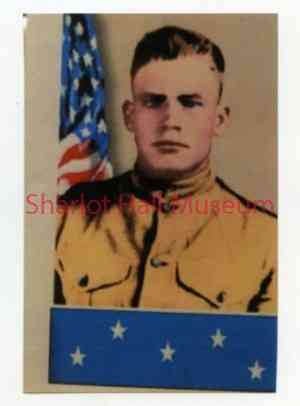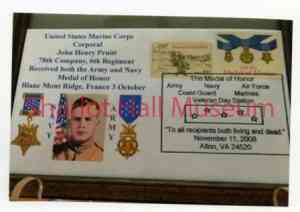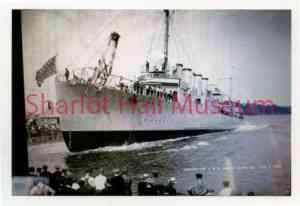By Elizabeth Bourgault
John Henry Pruitt was born on October 4, 1896 at Pruitt Hollow, near the small settlement of Fallsville, Newton County, Arkansas to George Benton and Melissa Belle Pruitt. Many sources list his birthplace as Fayetteville, Washington County, Arkansas, but this appears to be incorrect.
 As a youngster, John and his family moved first to McCabe, Arizona in 1907 and then to Jerome. John and his three siblings, Hurley Benton, Elizabeth Ellen and Mary Olive, are listed in school censuses in Jerome from 1908 through 1913, when John was 17. His father became a blacksmith in the Jerome mines, and eventually a police officer. After many years in Jerome, the Bisbee Directory of 1916-1917 show the Pruitts living in Bisbee. Mr. Pruitt was a miner, John a mucker (shoveling rock remnants) and Hurley a machinist. In 1918-1920, his family lived in Ray in Pinal County, where John’s father was a jigger boss at Arizona Hercules Co., and from there they moved to Alhambra, a suburb of Phoenix.
As a youngster, John and his family moved first to McCabe, Arizona in 1907 and then to Jerome. John and his three siblings, Hurley Benton, Elizabeth Ellen and Mary Olive, are listed in school censuses in Jerome from 1908 through 1913, when John was 17. His father became a blacksmith in the Jerome mines, and eventually a police officer. After many years in Jerome, the Bisbee Directory of 1916-1917 show the Pruitts living in Bisbee. Mr. Pruitt was a miner, John a mucker (shoveling rock remnants) and Hurley a machinist. In 1918-1920, his family lived in Ray in Pinal County, where John’s father was a jigger boss at Arizona Hercules Co., and from there they moved to Alhambra, a suburb of Phoenix.
According to Pruitt’s service record furnished to his family by the Marine Corps, John Henry enlisted in the Marine Corps on May 3,1917, shortly after the United States entered World War I.
On July 9th he qualified as a marksman and on July 21st, he joined the Seventy-Eighth Company, Sixth regiment at Quantico, VA.
Then it was off to France, as troops embarked on the transport ship U.S.S. Henderson from the Navy yard in Philadelphia, PA, on January 20, arriving in France on February 5th. ,1918. Upon arrival, the 78th Co., 6th regiment joined with the 2nd Division of the American Expeditionary Forces under General John J. Pershing.
 During the summer of 1918, Pruitt fought in some of the biggest battles of the war. From June 1st through the 14th, he participated in battles at Chateau-Thierry, Bouresches and Belleau Wood. On June 14, he was gassed and evacuated to the American Red Cross hospital to recover, returning to the front on July 22nd. From September 12th-15th, he was engaged in active operations against the enemy in St. Mihiel Sector. Pruitt was promoted to Corporal on August 15th and cited for bravery by General Pershing for distinguished and exceptional gallantry at Thiaucourt, France on September 15, 1918.
During the summer of 1918, Pruitt fought in some of the biggest battles of the war. From June 1st through the 14th, he participated in battles at Chateau-Thierry, Bouresches and Belleau Wood. On June 14, he was gassed and evacuated to the American Red Cross hospital to recover, returning to the front on July 22nd. From September 12th-15th, he was engaged in active operations against the enemy in St. Mihiel Sector. Pruitt was promoted to Corporal on August 15th and cited for bravery by General Pershing for distinguished and exceptional gallantry at Thiaucourt, France on September 15, 1918.
On October 3, 1918, during the battle at Blanc Mont Ridge, Corporal Pruitt single-handedly took out two enemy machine gun nests, killing the operators, and then captured 40 prisoners hiding in trenches. Later that same day, he was assigned to sniper duty and was hit by intense enemy fire and gravely wounded. He died the next day on October 4, 1918, on his 22nd birthday.
The news of his death did not reach his mother until December 20th. The last word from Corporal Pruitt came in a brief letter to his sister Elizabeth, stating that “his unit was taking part in a big battle, and that he had not had a blanket for six nights.”
 Corporal John Henry Pruitt was posthumously awarded the Navy Medal of Honor (the so-called rare first style “Tiffany Cross”), and the Army Medal of Honor for his heroism at Blanc Mont Ridge, France on October 3, 1918. He is one of only 19 servicemen to be awarded two Medals of Honor. Pruitt was also awarded numerous other medals, including the Croix de Guerre by France and the Croce di Guerra by Italy for his valor. General John J. Pershing included Corporal Pruitt on his list of 100 heroes of the war.
Corporal John Henry Pruitt was posthumously awarded the Navy Medal of Honor (the so-called rare first style “Tiffany Cross”), and the Army Medal of Honor for his heroism at Blanc Mont Ridge, France on October 3, 1918. He is one of only 19 servicemen to be awarded two Medals of Honor. Pruitt was also awarded numerous other medals, including the Croix de Guerre by France and the Croce di Guerra by Italy for his valor. General John J. Pershing included Corporal Pruitt on his list of 100 heroes of the war.
Pruitt was originally buried in the Meuse-Argonne Cemetery in Romagne, France. His remains were later returned to the United States and interred in Arlington National Cemetery on October 13, 1921.
In December of 1919, Mrs. Belle Pruitt received a telegram from Secretary of the Navy, Josephus Daniels: “I have assigned the name of Pruitt to Destroyer No. 347, under construction at Bath, Maine in honor of your son, Corporal John H. Pruitt, U.S.M.C., will you act as sponsor of the vessel?” Mrs. Pruitt responded in the affirmative. The U.S.S. Pruitt was launched on August 2, 1920, and christened by Belle Pruitt.
On April 22, 2003, the Pruitt family removed all existing medals from the Arizona State Capital Museum and presented them to the United States Marine Corps for display in the Marine Museum at Quantico, VA.
A section of the Medal of Honor Exhibit from Sharlot Hall Museum is now on display at Findlay Toyota on Willow Creek Road, including a panel honoring Corporal John Henry Pruitt.
“Days Past” is a collaborative project of the Sharlot Hall Museum and the Prescott Corral of Westerners International (www.prescottcorral.org). This and other Days Past articles are also available at https://sharlothallmuseum.org/articles/days-past-articles.l. The public is encouraged to submit proposed articles and inquiries to dayspast@sharlothallmuseum.org. Please contact SHM Library & Archives reference desk at 928-445-3122 Ext. 2, or via email at archivesrequest@sharlothallmuseum.org for information or assistance with photo requests.


